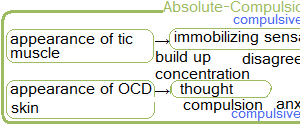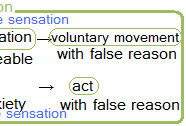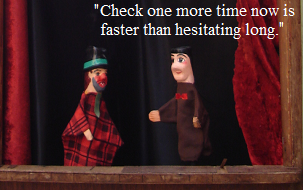The Kuriki method (the first edition in 2007) is a theory about Tourette’s syndrome (tic disorder) and obsessive-compulsive disorder to cure these diseases without medication. This theory is based on the author’s inference and interpretation regarding the structure of these diseases. Since it has been written for the psychoanalysts, reading will be difficult for people in general and it might be sometimes read erroneously. Therefore the Kuriki method must presuppose that the patient is treated by a nearby psychoanalyst, and that, between the patient and the Kuriki method, there is always the psychoanalyst. The explosion of emotional catharsis, which has strong repercussions, is done only for three seconds, once a week: beyond this rhythm, it would be an accident caused by negligence, and the psychoanalyst who is inexperienced in emotional catharsis must take responsibility for the temporary mental collapse caused by the accident. Also, to the patient who has weak capacity of logical reasoning, the psychoanalyst must explain well on the violent emotion of revenge caused by the illusory confusion between the person of the traumatic image in his head and the person in the real world.
Cure for Tourette’s syndrome (tic disorder) and OCD without medication
§16


The determination of a manner of tic movement
1. The Libido knows psychic motor units (i. e., muscle groups) by ordinary movements, which are done with a muscular contraction or a muscular tension. The manners of these psychic motor units are memorized with their localization and their bodily sensation of muscular contraction. According to the situation where these movements are done, a false reason becomes an attribute of each manner of tic movement. One of these motor units will be selected in rationalization as the muscle of « compulsive intramuscular sensation » of tic disorder. A movement that was done under an order of the parents, a teacher or a doctor can easily have legitimacy. For example, show the tongue to a doctor, close one eye at a visual acuity test, etc.
2. The Libido chooses arbitrarily a motor unit, and, at a moment of repression, makes « compulsive intramuscular sensation » of tic disorder in this group of muscles.
3. The Conscious is forced to do a tic movement in order to eliminate the disagreeable sensation that amplifies itself in the muscle of this motor unit. 4. The movement, which has succeeded in becoming an object of the Conscious will be a jurisprudence, a precedent, and this « compulsive intramuscular sensation » of tic disorder will be repeated.
4. The successful movement, which has become an object of the Conscious, will be a precedent, and this « compulsive intramuscular sensation » of tic disorder will be repeated.
1, 2, 3, 4 : All these steps are in the frame of a pathological structure, that is Absolute-Compulsion. Absolute-Compulsion does not permit anything else than a tic movement. Absolute-Compulsion is a tunnel that connects straight the « compulsive intramuscular sensation » of and a tic movement, without any other exit. Absolute-Compulsion is the structure itself of the disease, rather than a force.
The false reasons, with which the Conscious does voluntary movements, must be reasons that can pass the censorship of the Super-ego. Since the false reasons appear in the Conscious, they are ideas that can be expressed with words; “Because …”. The Unconscious invents these false reasons, therefore they are extremely childish. This infantilism passes easily the Superego, which is childish too.
For example, false reasons of eye rolling tic can be;
“Because my eyes are tired, a little bit of exercise of the eyes is needed.”
“Because the verification of the mobility of the eyes is important.”, etc.
Alternatively, ideas in hypothetical form, such as ;
“if my eyes were not tired, this eye movement would not be necessary” etc.
Just like the fox, who would say : “If these grapes were ripe, I would take them.”
These false reasons can not force tic movements, but they pass in the head collaterally at the moment of a tic movement. While the Freudian Super-ego develops from the age of 5 years, the onset of tic disorder can be already at the age of 2 years. Thus, the Freudian Super-ego is not the issue concerning tic disorder. Among the structural elements of the Kuriki method, there is neither Ego nor Id. A conscious movement of tic is always accompanied by a false reason, but the validity of this false reason is not necessary for very small children. In this sense too, a tic movement is not forced by a false reason.
The typical feature of these false reasons is that they are extremely simple and extremely childish. The Conscious denies the validity of false reasons in the rational Conscious. But the Unconscious does not deny the validity of false reasons in the irrational Unconscious. The Super-ego has already accepted the legitimacy of these false reasons. You must understand the stubbornness of the Super-ego by separating clearly the Conscious and the Unconscious. Rationalization is a conspiracy of the childish Libido and the childish Super-ego in the Unconscious. No matter how the Conscious rejects in the Conscious the content of a rationalization, the Unconscious is independent and indifferent. The rationality of the Conscious can not enter the Unconscious.
KV is a function pathological of bodily repression of disagreeable bodily sensations, especially bodily sensations such as the genitals and the excretory organs; primitive repressed sensations. The « compulsive intramuscular sensation » of tic disorder deviates the intentionality of the Conscious, in order to avoid these repressed sensations. For example, the bodily sensation of the pressure by the quantity of urine in the bladder is repressed by the « compulsive intramuscular sensation » of tic disorder in the voluntary muscle of the shoulder, for example, i. e., the Conscious looks at the shoulder, and does not look at the bladder. The primitive repressed sensations and the « compulsive intramuscular sensation » of tic disorder are rivals, because they are different, and at the same time, they are rivals, because they are of the same kind, just like List and Chopin were rivals because they played the piano differently, and at the same time, they were the same kind. The sensation of the bladder and the « compulsive intramuscular sensation » of tic disorder of the shoulder are different, and at the same time, they have an element of the same category. For children, sexual desire and genital bodily sensations are separated in the Conscious, but in the Unconscious, on the libidinal level, they should be together. The « compulsive intramuscular sensation » of tic disorder is not a primitive sensation. The « compulsive intramuscular sensation » of tic disorder is a rival of primitive repressed sensations, therefore, the « compulsive intramuscular sensation » of tic disorder has an element of the same category as primitive repressed sensations. It is the corporality of the symptoms of neurosis. In Kuriki method, the Super-ego is defined as the function that represses the Libido, except for sexual desire, this is the answer why manners of tic movement can pass through the Super-ego. The « compulsive intramuscular sensation » of tic disorder is made directly in the muscles by Libido without passing through the Super-ego. The energy of the Libido manifests itself into the outside world by means of a bodily act.
Before some examples of false reasons of rationalization in tic disorder, to facilitate understanding of the false reason, we see first some examples of false reasons in obsessive-compulsive disorder and impulse control disorder.
“thoughts” and “false reasons”
Ideas, such as “2 plus 2 is 5.”, “Mona Lisa is symmetric” are wrong ideas. On the other hand, thoughts of obsessive-compulsive disorder, such as “The number must be 3.”, “The curtains must be symmetrical” are not mistakes. Thoughts of obsessive-compulsive disorder are irrational. “The number must be 3.” This is the same childish Libido, which says : “The shoes must be red.”
The thoughts of obsessive-compulsive disorder are accompanied by a false reason. For example, “Because the triangle is stable.”, “Because symmetry is beautiful.” etc. ; one of these false reasons comes to mind at the moment of an action. False reasons are childish.
The rationalization in obsessive compulsive disorder chooses a “thought”, which is obviously irrational. The types and the contents of acts and thoughts, which have been chosen by the rationalization of obsessive compulsive disorder, have no therapeutic importance. The thought in itself and the act in itself has no pathological significance, but the compulsiveness of a thought and the compulsiveness of an act are pathological as neurosis. In the Conscious of the patient, it is not the thought that forces an act, but it is the amplification of a feeling of insecurity and the amplification of a compulsive sensation by the bodily sensation (such as cutaneous sensation) of «the compulsive physical sensation» of OCD that force an act. The main symptoms of neurosis are bodily symptoms, and «the compulsive physical sensation» of OCD feels like the bodily sensation of adrenaline secretion. Bodily reactions to the adrenaline secretion vary individually, but skin sensitivity is much probable. The Libido makes directly on the skin a sensation that is an imitation of the sensation of the adrenaline secretion, and the Conscious interprets this cutaneous sensation as a feeling of insecurity.
Examples of the false reasons of obsessive compulsive disorder and impulse control disorder.
As the choice of false reasons is a personal question, there are various possibilities.
As “It is good to cut the nails”, often the legitimacy of false reasons has been given by others; the parents, the teachers, etc. The legitimacy of good behaviors of good children.
1. Trichotillomania (Impulse control disorder)
“Because there are a lot of hairs.”
“Because hair will grow back.”
“Because hair is not necessary.”, etc.
The legitimacy of false reasons passes the Super-ego. The true cause of a trichotillomania has no relation to hair. The arbitrary selection (i. e., rationalization) chooses a trichotillomania among several KVs, and this
trichotillomania functions as a means of repression. The problem of this bothersome trichotillomania will be a big object of the Conscious.
2. Onychophagia, or nail biting (Impulse control disorder)
“If there was a nail clipper here, I would use it.” That is just like the fox ; “If those grapes were good, I would take some.”
“Because fingernails grow quickly.”
“Because cutting fingernails is a good action.”
“Because teeth cut fingernails faster than a nail clipper.”
“As there are teeth, nail clipper is not necessary.”
A lot of false reasons are possible.
3. In order not to inundate the house during the absence, the confirming check of the faucets is justified. The Super-ego justifies the confirming as many times as the Libido wants. The enduring conflict between the rationality of the Conscious and the irrationality of this repetition will be a big object of the Conscious, and a primitive sensation, for example, will be repressed.
4. “Good children wash their hands with soap.”
Hand washing is a good behavior, the Super-ego doesn’t refuse it. The Super-ego justifies hand washing as many times as the Libido wants. As a disinfection of bacteria, the anus should be washed, but the anus is a primitive sensation and it is an object of the bodily repression (KV).
5. The repeating confirmation of the contents of an envelope to send.
“Once closed (or, once sent), no verification will be possible.”
“Rather than hesitate long to check, check for the last time is faster.”
6. Compulsive hoarding is a symptom of obsessive-compulsive disorder. The visible symptom of a garbage clutter and the false reason (the superficial motive) have no therapeutic importance. The orientation of the treatment is not toward “why accumulate garbage”, but “why a neurosis.” If the patient had no compulsive hoarding, he could have trichotillomania. This arbitrariness of symptom is the rationalization in the Kuriki method. A compulsive hoarding in the Absolute-Compulsion of compulsive hoarding. For a patient, not to accumulate garbage is as impossible as not to breathe.
False reasons are childish.
“Because these things will be able to be used someday.”
“Because throwing is wasting.”
“Pity for these things.”
etc.
Becoming a child under 5 years is a way of the Libido to pass the Super-ego, and this way is also applied to sexual acts of adult persons.
· Counting the number of things is an imitation of small children.
· Arrangement of objects on the table is an imitation of playing blocks.
· Thumb sucking is an imitation of babies.
(In the interpretation by Freudian psychoanalysis, infantilization is a regression of the Ego, against the reality principle. For example, some people eat chewed ends of fingernail. A return to the stage of a baby, who puts anything in the mouth, namely, going back to the period prior to the trauma. Likewise, trichotillomania.)

